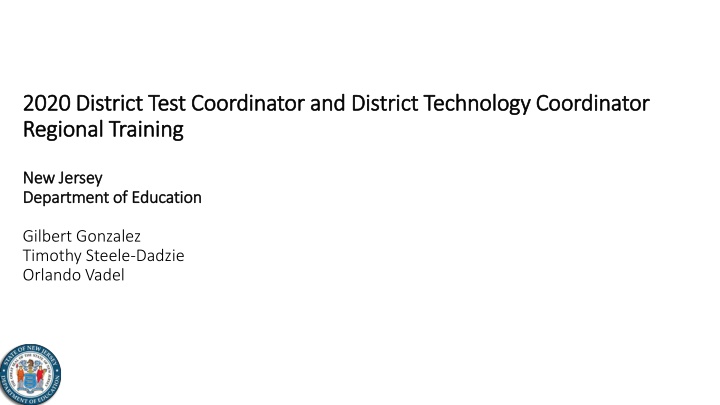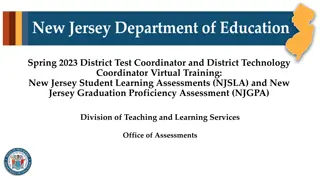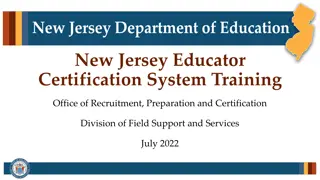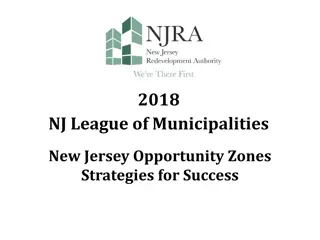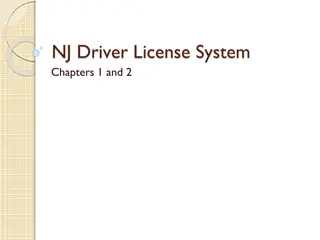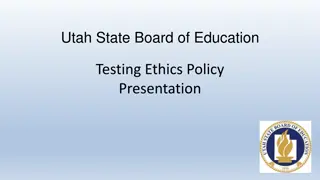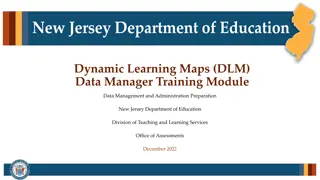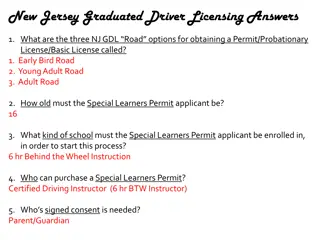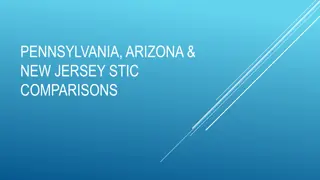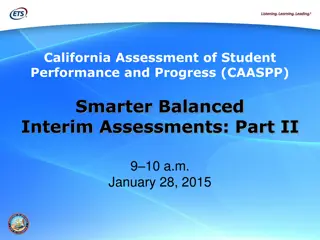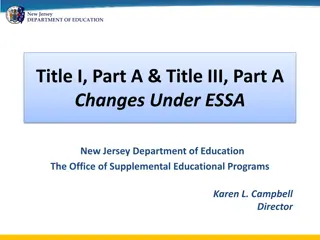Enhancing State Assessments in New Jersey: Training, Security, and Improvements
The New Jersey Department of Education focuses on providing equitable access to high-quality education for its 1.4 million students through rigorous state assessment programs. District Test Coordinators play a crucial role in ensuring proper training, security measures, and data accuracy. The assessments include strict security protocols, comprehensive test development, and informative data reporting to drive educational enhancements. Continuous feedback and improvements are sought through phases of discussions, webinars, and practitioner engagement, with a focus on technological advancements and accessibility. Notable updates for Spring 2020 include enhanced score interpretation guides and reporting resources, aiming to support educators, parents, and students in the assessment process.
Uploaded on Sep 15, 2024 | 0 Views
Download Presentation

Please find below an Image/Link to download the presentation.
The content on the website is provided AS IS for your information and personal use only. It may not be sold, licensed, or shared on other websites without obtaining consent from the author.If you encounter any issues during the download, it is possible that the publisher has removed the file from their server.
You are allowed to download the files provided on this website for personal or commercial use, subject to the condition that they are used lawfully. All files are the property of their respective owners.
The content on the website is provided AS IS for your information and personal use only. It may not be sold, licensed, or shared on other websites without obtaining consent from the author.
E N D
Presentation Transcript
2020 District Test Coordinator and District Technology Coordinator 2020 District Test Coordinator and District Technology Coordinator Regional Training Regional Training New Jersey New Jersey Department of Education Department of Education Gilbert Gonzalez Timothy Steele-Dadzie Orlando Vadel
Welcome Our Mission: The New Jersey Department of Education (NJDOE) supports schools and districts to ensure New Jersey s 1.4 million students have equitable access to high-quality education and that they achieve academic excellence.
Turn-key training is a vital component to ensuring that students are supported through the assessment process and data is secure and accurate. Your District Test Coordinators are responsible for ensuring that all district and school personnel involved in the administration of New Jersey state assessment programs have been trained. Contribution and Impact State Assessment Coordinators are available to support districts in ensuring the statewide assessment program is implemented with fidelity. 3
What Makes State Assessments Different Security procedures: Rigorous test security protocols ensure an accurate measure of student performance. Test Development: Development includes several item reviews to ensure equitable access among all student populations. Data and reporting: Informs federal and state accountability systems, including school and district decisions on curriculum. State and federal requirements: Participation is required by federal and state law to ensure all students have access to a high-quality education. 4
Informing Improvements: Phase I and II Summary Phase I: May-July 2018 Phase II: January-April 2019 75 conversations around the state and 3 webinars 243 practitioners 151 districts 21 counties 21 counties 2,363 of New Jersey residents technology and platform --- assessment design --- data and reporting --- implementation --- accessibility --- student portfolio appeals Over 3,200 suggestions for improvements 5
Whats New for Spring 2020 Updated score interpretation guides New reporting resources for educators and parents in the New Jersey Student Learning Assessments Resource Center Parent Portal Video Score Reports NJDOE Digital Item Library Tech Support Office Hours 6
Scheduling Scheduling Spring 2020 District Test and Technology Coordinator Training 7
Spring 2020 Statewide Assessments Testing Schedule Computer Computer- -Based Testing (CBT) Testing (CBT) Based Paper Paper- -Based ( (PBT) PBT) Based Testing Testing Assessment Assessment Grades Grades Regular Administration (ELA and Math) 3 through 10 4/20/20 to 5/29/20 4/20/20 to 5/1/20 Spring Block (ELA and Math) 9 and 10 4/27/20 to 6/8/20 4/27/20 to 5/8/20 Science 5, 8, and 11 4/20/20 to 5/29/20 4/20/20 to 5/1/20 Summer Administration (ELA and Math) 9 and 10 7/27/20 to 8/7/20 7/27/20 to 8/7/20 Portfolio Appeals (ELA and Math) 12 N/A 1/6/20 to 5/8/20 Dynamic Learning Maps (DLM) (ELA, Math and Science) 3 to 8, 11 4/1/20 to 5/29/20 N/A 8
Key Spring Dates for 2020 Activity Activity Owner Owner Key Dates Key Dates ELA/Math: Starting January 22, 2020 Review and Update Student Registration/Personal Needs Profile (SR/PNP) information in PearsonAccessnext (PAN) Districts Science: December 5 to January 3, 2020 (initial registration) Infrastructure Trial Begins Districts February 3, 2020 ELA/Math: All test materials are expected to arrive in district no later than April 3, 2020 Paper Materials Arrive in District NJDOE/Districts Science: All test materials are expected to arrive between April 7 to 9, 2020 9
Key Spring Dates for 2020, continued For specific activities and dates, please download the Spring 2020 ELA/Math Key dates and the Spring 2020 Science Key dates. Activity Activity Owner Owner Key Dates Key Dates ELA/Math: April 6, 2020 Additional Order Window Begins Districts Science: April 7 to 27, 2020 Regular Administration: May 8, 2020 Deadline to Return Secure Scorable Test Materials to Vendor Districts Spring Block Administration: May 15, 2020 10
Unit Test Times for ELA: Non-Field Test Schools ELA ELA Unit 1 Unit 1 Unit 2 Unit 2 Total Test Time Total Test Time 75 minutes 75 minutes 2 hours 30 minutes Grade 3 90 minutes 90 minutes 3 hours Grades 4 to 5 Grades 6 to 10 90 minutes 90 minutes 3 hours Note: Unit times do not include the recommended 25 to 30 minutes for logging students Note: Unit times do not include the recommended 25 to 30 minutes for logging students on, reading directions from the Test Administrator Manual (TAM), and logging students on, reading directions from the Test Administrator Manual (TAM), and logging students off. off. 11
Unit Test Times for ELA: Field Test Schools ELA ELA Unit 1 Unit 1 Unit 2 Unit 2 Unit 3 Unit 3 Total Test Time Total Test Time Grade 3 75 minutes 75 minutes 75 minutes 3 hours 45 minutes Grades 4 to 5 90 minutes 90 minutes 90 minutes 4 hours 30 minutes Grades 6 to 10 90 minutes 90 minutes 90 minutes 4 hours 30 minutes Note: Unit times do not include the recommended 25 to 30 minutes for logging students Note: Unit times do not include the recommended 25 to 30 minutes for logging students on, reading directions from the Test Administrator Manual (TAM), and logging students off. on, reading directions from the Test Administrator Manual (TAM), and logging students off. 12
Unit Test Times for Mathematics Mathematics Mathematics Unit 1 Unit 1 Unit 2 Unit 2 Unit 3 Unit 3 Total Test Time Total Test Time Grades 3 to 5 60 minutes 60 minutes 60 minutes 3 hours Grades 6 to 8 60 minutes 60 minutes 60 minutes 3 hours Algebra I, Geometry, Algebra II 90 minutes 90 minutes N/A 3 hours Note: Unit times do not include the recommended 25 to 30 minutes for logging students on, reading Note: Unit times do not include the recommended 25 to 30 minutes for logging students on, reading directions from the Test Administrator Manual (TAM), and logging students off. directions from the Test Administrator Manual (TAM), and logging students off. 13
Unit Test Times for Science Science Science Unit 1 Unit 1 Unit 2 Unit 2 Unit 3 Unit 3 Unit 4 Unit 4 Total Test Time Total Test Time Grade 5 45 minutes 45 minutes 45 minutes 45 minutes 3 hours Grade 8 45 minutes 45 minutes 45 minutes 45 minutes 3 hours High School 60 minutes 60 minutes 60 minutes 60 minutes 4 hours Note: Unit times do not include the recommended 25 to 30 minutes for logging students on, reading Note: Unit times do not include the recommended 25 to 30 minutes for logging students on, reading directions from the Test Administrator Manual (TAM), and logging students off. directions from the Test Administrator Manual (TAM), and logging students off. 14
Scheduling Test Units: Requirements Two units max per day per student Units within a content area must be administered in sequence (i.e., Science Unit 1, followed by Unit 2, followed by Unit 3, followed by Unit 4) Students with an extended time accommodation, as specified by their Individualized Education Program (IEP), 504 Plan, or English Language Learner (ELL) Plan, should begin testing in the morning and complete a given unit by the end of that school day 15
Scheduling Test Units: Flexibilities Testing may be scheduled for any school day during the 30-day testing window Absent students can resume testing with their assigned group and be assigned to make-up sessions for units missed No special order is required for administration by grade or content area (math followed by ELA or ELA followed by science, etc.) Back to back units are permitted; students must have a supervised break between units Multiple groups of students can be scheduled in a single day (AM Group 1 takes two units; PM Group 2 takes two units, etc.) If necessary, grades may be combined for the same content area if unit test times and read aloud test directions are the same 16
Testing Requirements Testing Requirements Spring 2020 District Test and Technology Coordinator Training 17
Testing Requirements: Overview All public schools are required by state and federal law* to test all students in grades 3 to 8 and high school. The following slides outline testing requirements and considerations for specific populations of students. Elementary school English Language Learners Middle school Students with Disabilities High school Adult Education *See requirements in the Every Student Succeeds Act (ESSA) sec. 1111(b) and N.J.A.C. 6A-8-4.1(d) 18
Who Must Test: Elementary and Middle School All students in grades 3 through 8 are expected to participate in statewide assessments based on their current grade level enrollment, not on the level of instruction received during the academic school year. The only exception is for middle school students who are taking any of the high school math courses (i.e., Algebra I, Geometry, Algebra II). These students are expected to take the end of course assessment that matches their mathematics course enrollment. 5th, 8th, and 11th grade students must participate in the science assessments. Elementary and middle school students with disabilities, except those with the most significant intellectual disabilities who qualify for the DLM, must participate in statewide assessments. 19
Who Must Test: Middle School Math Middle school students enrolled in a one-year Algebra I or Geometry course must take the Algebra I or Geometry assessment instead of their grade-level math assessment. Middle School students enrolled in a two-year Algebra I or Geometry course must take their grade-level math assessment in the first year of the course, then take the Algebra I or Geometry assessment in the second year of the two-year course. Middle school students enrolled in multiple high school level mathematics courses (Algebra I, Geometry, Algebra II) will take only one math assessment. 20
Who Must Test: High School Math High school (HS) students in grades 9 and 10 not enrolled in a tested math course will not take a state assessment If a HS student retakes a course they did not pass in the prior year, but they did pass the assessment, they are not required to take the assessment again HS students currently enrolled in an Algebra I, Geometry, or Algebra II course must take the corresponding state assessment unless they are repeating the course, but have previously passed the assessment associated with the course HS students enrolled in multiple math courses will take only one state math assessment per assessment administration. A student should take Algebra I to meet their primary graduation pathway requirement in cases where students are taking Algebra I and Geometry. 21
Who Must Test: High School Math, continued HS students enrolled in an integrated math course that includes Algebra I or Geometry, and is a prerequisite for an Algebra I or Geometry course, do not take the Algebra I or Geometry assessment while enrolled in the course These students must wait until they are enrolled in the Algebra I or Geometry course to take the test HS students enrolled in an integrated math course that includes Algebra I or Geometry, and is an alternative to an Algebra I or Geometry course, must take the Algebra I or Geometry assessment 22
Who Must Test: High School ELA 9th and 10th grade students must take the grade level specific ELA assessment regardless of the ELA course they are currently enrolled in. Exception: Students repeating a course who have previously passed the associated assessment are not required to re-take that assessment. Students enrolled in multiple ELA courses will take only one ELA assessment, as deemed appropriate by the school district. Exception: If one of the multiple ELA courses is Grade 10 ELA, the students must take the Grade 10 ELA assessment. Grade-level ELA course/credit assignment determines participation in statewide assessments, not the grade-level homeroom assignment. 23
Who Must Test: High School Science High school students are required to participate in the statewide science assessment in grade 11. This requirement is determined by credit total, not homeroom assignment. Example: A 10th grade student who has attained enough credits to be considered an 11th grade student, but has a grade 10 homeroom, would take the science assessment. Example: An 11th grade student who has attained enough credits to be considered a 12th grade student, but has a grade 11 homeroom, would not take the science assessment. 24
Graduation Assessment Requirement Classes of 2020-2022 Pathway I Demonstrate proficiency in the high school end-of-course state assessments in ELA-10 and Algebra I English Language Arts (ELA) Mathematics NJSLA/PARCC ELA Grade 10 750 (Level 4) NJSLA/PARCC Algebra I 750 (Level 4) 25
Graduation Assessment Requirement Classes of 2020-2022, part two Pathway II Demonstrate proficiency in ELA and/or mathematics by meeting the designated cut score on one of the alternative assessments. See cut scores for each assessment here. Alternative Assessments: ELA Alternative Assessments: Math NJSLA/PARCC Geometry NJSLA/PARCC Algebra II SAT Math (taken before 3/1/16) SAT Math Section SAT Math Test ACT or ACT PLAN Math1 ACT Aspire Math1 ACCUPLACER Elementary Algebra Next-Generation ACCUPLACER Quantitative Reasoning, Algebra, and Statistics (QAS) PSAT10 Math or PSAT/NMSQT Math ASVAB-AFQT NJSLA/PARCC ELA Grade 9 NJSLA/PARCC ELA Grade 11 SAT Critical Reading (taken before 3/1/16) SAT Evidence-Based Reading and Writing Section SAT Reading Test ACT Reading or ACT PLAN Reading1 ACT Aspire Reading1 ACCUPLACER WritePlacer ACCUPLACER WritePlacer ESL PSAT10 Reading or PSAT/NMSQT Reading ASVAB-AFQT 26
Graduation Assessment Requirement Classes of 2020-2022, part three Pathway III Demonstrate proficiency in English language arts and/or mathematics through Portfolio Appeals, which includes: Student transcripts and the district intervention plan for student Performance on state and alternate competency assessments Constructed-Response Tasks or CRTs in the subject areas in which the student is deficient (ELA and/or math) CRTs are designed, administered, and graded locally according to state assessment evidence statements CRTs must be designed for students to demonstrate competency in state standards (in ELA and/or math) Additional general information as needed The Portfolio Appeals Process is available to students at the beginning of their 12th grade year. 27
Who Must Test: ELLs All English Language Learners must take the New Jersey state assessments. Students who are newly arrived English Language Learners (ELLs) must take the math and science assessments. Newly arrived ELLs in grades 3 through 10 are exempt the ELA state assessment for their first school year. Note: students are considered newly arrived if they enter the country after July 1 of the prior academic year. ELLs from Puerto Rico are eligible for this exemption. ELLs enrolled in English as a Second Language (ESL) (beginner, intermediate, or advanced level) must take the ELA assessment associated with their course equivalent/credit assignment, not the level of the ESL course. 28
Who Must Test: Special Education Students with disabilities, except those with the most significant intellectual disabilities who qualify for the Dynamic Learning Maps (DLM) assessment, are required to take state assessments. Students with IEPs that are exempt from passing: Are required to take all appropriate statewide assessments only once Are not required to pass statewide assessments, alternate graduation assessments, or participate in the portfolio appeals process 29
Alternate Assessment Eligibility-DLM Only those students who have a significant intellectual disability should be taking the DLM assessments. This subgroup of students is approximately one percent of students with disabilities. The vast majority of students with disabilities will take the NJSLA assessments with appropriate accommodations. The IEP team will determine which of the NJSLA accommodations the student will receive and document this in the IEP. Under ESSA, only one percent of students can take the alternate assessment (DLM). Anticipated performance on the general education assessment or behavior concerns during testing are not valid reasons for having a student participate in the alternate assessment. Review the updated DLM Participation Guidelines for further information. English Language Learners who take the DLM are eligible to take the Alternate-ACCESS. Review the Alternate-ACCESS Participation Criteria for further information. 30
Alternate Assessment Eligibility-DLM, continued Districts who anticipate more than one percent of students taking the DLM assessment can request a waiver. Review of waiver requests from previous years demonstrated that some districts have more than five percent of students taking the alternate assessment. ESSA requires the NJDOE to conduct activities in districts that exceed the one percent cap. This could consist of file review, interviews and technical assistance. 31
Who Must Test: Adult High School Students Adult high school students enrolled in a currently assessed course (Algebra I, Geometry, Algebra II) are not required to take the associated statewide assessment. Adult high school students who passed any historical statewide assessment (HSPT, HSPA, etc.) will have their passing scores banked and counted toward their graduation testing requirement. These students will not take the current state assessments. Adult high school students who took, but did not pass, any historical statewide assessments must meet the graduation assessment requirement via the alternative pathways or the portfolio appeal process. Note: Students who did not pass a historical statewide assessment in any one content area (ELA or math) must rely on the alternative pathways or portfolio appeals process to meet the graduation assessment requirements for that content area. 32
Homebound Students, Bedside Instruction, and Non-Testing Out-of-District Placements Homebound students, or those receiving bedside instruction, must be tested unless they meet the definition of medical emergency. A medical emergency is defined as the occurrence of a severe medical or psychiatric condition or episode that requires medical attention or supervision, during which time a student is unable to participate in statewide assessments. These students, as well as students in a situation where an Out-of-District placement does not administer state assessments, may be administered the paper- or computer- based assessment by having the accountable school send a Test Administrator to the student s location. Students should be tested during the hours they normally receive instruction. Any accommodation(s) specified for state assessments should be in alignment with those routinely used by students during classroom instruction and locally- administered assessments. 33
Homebound Students, Bedside Instruction, and Non-Testing Out- of-District Placements Test Administrator Qualifications and Requirements Licensed professional employed by the district Trained by the district or school test coordinator Signs appropriate chain of custody forms and test security agreement Maintains test security at all times Has access to technology coordinator and test coordinator for support and guidance Returns all secure testing materials to school test coordinator or district test coordinator as soon as possible after testing is completed Guidance for administering assessments to homebound, bedside, and non-testing Out-of- District placement students can be found on the NJDOE assessment district guidance page. 34
Testing Site Requirements, continued Students must be well spaced with ample surface area Provide assigned seating Provide good lighting and ventilation Use clock and chart to display time remaining Never leave students unattended Always supervise students including during restroom breaks Hallways should be monitored to keep testing rooms undisturbed Post Testing Do Not Disturb signs on testing room doors 35
Testing Site Requirements The following behaviors and materials are not permitted in testing rooms: Coats, backpacks, or purses Instructional displays Buzzers, bells, or non-emergency announcements or interruptions during testing Cell phones, MP3 players, or any unauthorized electronics Food or beverages (except if permitted by IEP or 504) Note: this list is not exhaustive 36
Accessibility Features and Accommodations Accessibility Features and Accommodations Spring 2020 District Test and Technology Coordinator Training 37
Accessibility Features: Overview The purpose of administrative considerations, accessibility features, and accommodations is to remove barriers to accessing the assessment content for all participating students. These features do not provide advantages to student performance; they enable students with specific needs to access the assessment content to demonstrate their proficiency. Some features are readily available for student use, and some must be identified in advance and enabled in a student's SR/PNP data file. Use student data and set planning meetings with teachers and special education support staff to ensure students receive the supports they need. 38
Accessibility Features and Accommodations, continued Administrative Administrative Considerations Considerations for All Students for All Students Accessibility Features Accessibility Features for all Students for all Students (Including Identified in (Including Identified in Advance) Advance) Accommodations Accommodations for Students with for Students with Disabilities, 504, Disabilities, 504, ELL Only ELL Only 39
Administrative Considerations for All Students Small Group Testing Time of Day Separate or Alternate Location Specified Area or Setting Adaptive and Specialized Equipment or Furniture Frequent Breaks 40
Accessibility Features for All Students Answer Masking* Audio Amplification Bookmark Color Contrast* Blank Scratch Paper Eliminate Answer Choices General Administration Directions Clarified General Administration Directions Read Aloud and Repeated as Needed Highlight Tool Headphones or Noise Buffers Line Reader Mask Tool Magnification/Enlargement Device Notepad Pop-up Glossary Redirect Students to the Test Spell Check or External Spell Check Device Student reads Assessment Aloud to Self* Text-to-Speech for Mathematics/Science* Human Reader/Human Signer for Mathematics/Science* Writing Tool * = must be identified in advance 41
Accommodations for Students with Disabilities IEP or Section 504 Plan teams are responsible for making all accommodation decisions. Accommodations must be documented in an approved IEP or Section 504 Plan. Students should have prior experience using the accommodation routinely during classroom instruction and on locally-administered assessments. 42
Presentation Accommodations for Students with Disabilities Assistive Technology Screen Reader Version Refreshable Braille Display with Screen Reader Version for ELA Hard Copy Braille Edition (provided in Unified English Braille) Tactile Graphics Large Print Edition (provided in 18-point font on paper sized 14 x18 ) Paper-Based Edition (must have a valid IEP or Section 504 Plan) Closed Captioning of Multimedia on ELA American Sign Language (ASL) Video for Mathematics/Science Human Signer for Test Directions ELA Assessments, including items, response options, and passages Text-to-Speech American Sign Language (ASL) Video Human Reader/Human Signer 43
Response Accommodations for Students with Disabilities Assistive Technology (Non-Screen Reader) Braille Note-taker Braille Writer Calculation Device (on Calculator Section of Mathematics Assessment) Calculation Device and Mathematics Tools (on Non-Calculator Sections of Mathematics Assessment) ELA Selected Response Options, ELA Constructed Response Options and Math/Science Response Options Speech-to-Text Human Scribe Human Signer Assistive Technology Device Monitor Test Response Word Prediction External Device 44
Speech-to-Text Guidance If the product is used routinely by the student during classroom instruction, students receiving Speech-to-Text as an accommodation may use a third-party web-based product that requires the use of the internet to initiate the product. Student must test one-to-one (i.e., test administrator and student). Test Administrator must monitor the student. Technology Coordinator must verify third-party device was not used to access the internet outside of its original purpose. 45
Text-to-Speech Guidance The text-to-speech feature needs to be turned on for each student in their SR/PNP. Considerations should be made during assignment, as these supports must mirror what supports students receive during their regular classroom instruction. For ELA, text-to-speech is an accommodation. Students must have a valid IEP or 504 plan to access this feature. For math and science, text-to-speech is an accessibility feature. IEPs and 504 Plans are not necessary to use this feature for math and science; however, it should not be administered to all students simply because it is available. Students using text-to-speech should be familiar with the functionality of the tool prior to using it on a state assessment. 46
Extended Time (must have a valid IEP or Section 504 Plan) Students have until the end of the school day to complete a single test unit administered during the prescribed testing window. Timing and Scheduling Accommodation for Students with Disabilities Students receiving this testing accommodation should be tested in a separate setting to minimize distractions to other students, and to schedule for testing in the morning to allow adequate time to complete a test unit. 47
Accommodations for English Language Learners (ELLs) ELL teams are responsible for making all accommodation decisions. Accommodations for ELLs must be documented in the student s ELL Plan. Students should have prior experience using the accommodation routinely during classroom instruction and locally-administered assessments. Newly arrived ELLs, in grades 3 through 10, who are enrolled in United States schools after June 1 of the prior school year, may be excluded from taking the ELA assessment in the current school year. Students classified as ELLs whose parent/legal guardian has refused language support services are eligible to receive ELL testing accommodations as deemed appropriate. 48
Accommodations for ELLs Online Transadaptation of the Mathematics/Science Assessment in Spanish Extended Time Word-to-Word Dictionary (English/Native Language) Paper-Based Edition of Mathematics/Science Assessment in Spanish Mathematics/Science Response Speech- to-Text or Human Scribe General Administration Directions Read Aloud and Repeated in Student s Native Language* Large Print Edition of the Mathematics/Science Assessment in Spanish General Administration Directions Clarified as Needed in Student s Native Language Text-to-Speech or Human Reader for the Mathematics/Science Assessment in Spanish Note: Read aloud directions are available in the following languages: Arabic, Bengali, Chinese Mandarin, Gujarati, Haitian Creole, Korean, Portuguese, Russian, Spanish, Urdu. Science translation available in Spanish only. 49
Test Security and Information Security Test Security and Information Security Spring 2020 District Test and Technology Coordinator Training 50
